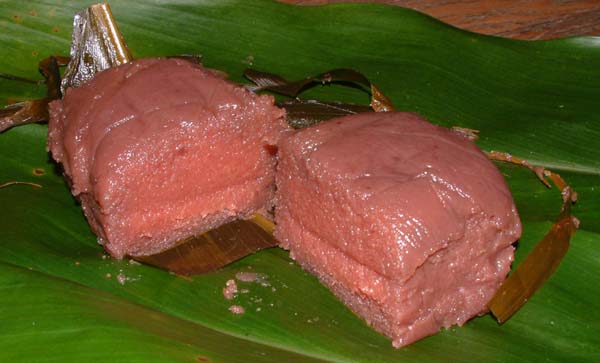|
Making Kulolo:
A version of kulolo.
|
“Making kulolo, it’s getting to be a lost art,” ‘Ilima says. “Because there are some people that make kulolo and they sell it. And it is so much easier to buy a slab of kulolo, because it takes a lot of work. I remember, my Mom made very good kulolo. What she usually did was grate the coconut first. She had a grater, and my Dad would sit on it and just grate the coconut. And then you add water, hot water to the coconut to get the milk. And you would put it in a strainer and squeeze and squeeze until you got all of the milk you could get out of the coconut. Then you would reserve the grains of the coconut because this is what you going to use to rub on your hand when the taro makes it itchy. “You need to grate the taro. The coconut grater, it had little spines coming out, but the taro needed to be finer. And you need to have uniform sizes of taro. You can’t have big taro, small taro. She’d get taro about 3 inches across, all the same size. And peel—you need to peel the taro, and of course taro is very itchy, the milk that comes out. So you grate the taro. When itchy, you put your hand in the grated coconut and rub, rub, rub, and grate again. “Kulolo uses coconut milk and the taro, brown sugar and honey. And if you put too much honey, it turns a little sour. So you need to be careful when you mix your kulolo. It was all in the hand, something about the Hawaiian hand. You know, not everybody, when they mix poi will turn sour. The Hawaiian people want the poi after two or three days to get sour or poha [fermented]. And not everybody’s hand will do it. There are some people that can mix poi and that poi never gets sour. So it’s all in the hand; the kulolo, you mix by hand. “To cook it, we use to have those cracker cans. It used to be you could buy round crackers from the store, that came in this can. And it was about a foot and a half long, and like inches. Then you would lay it flat long way and then you cut three corners and we could flap it back. And then you would line the bottom and the sides of this cracker can with banana leaves and ti leaves. And then on the bottom would put the grains from the coconut. So it doesn’t papa‘a. Because you are going to put it in the imu. Then so you kind of put all that grated coconut for cushion or whatever. You put all the coconut and then more ti leaves, otherwise the coconut would all go into the mix. So you put ti leaves, coconut, ti leaves and then you pour in your kulolo. And then you would put it in the imu. Cover them over, like how you kalua pig: put it in the imu. “And then when kulolo time, because it was such work, we would share with all the neighbors and the ‘ohana. And usually kulolo was made when you had a lu‘au. Because we never had cakes those days, we just had kulolo, haupia, palau [ko‘elepalau]—sweet potato with coconut milk. You would mash the sweet potato and then you would add coconut milk. Oh, that is good. So we had palau, kulolo, haupia, sweet potato, just kalua the sweet potato. Now we have cakes and Jellos and all sorts of things. But we never had, in those days when we made a lu‘au.”
|
||
|
|
||
|
|||||
|
|||||

